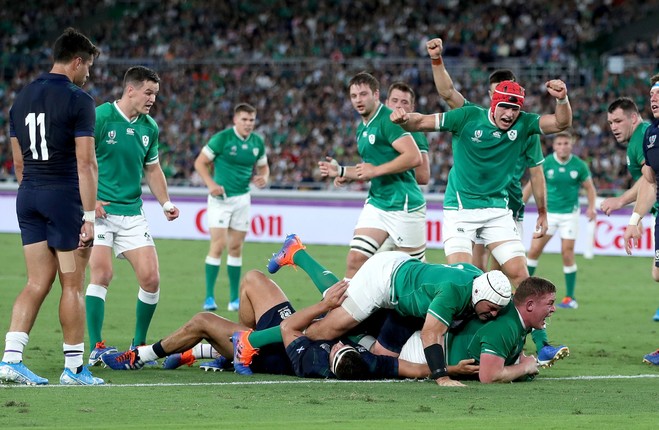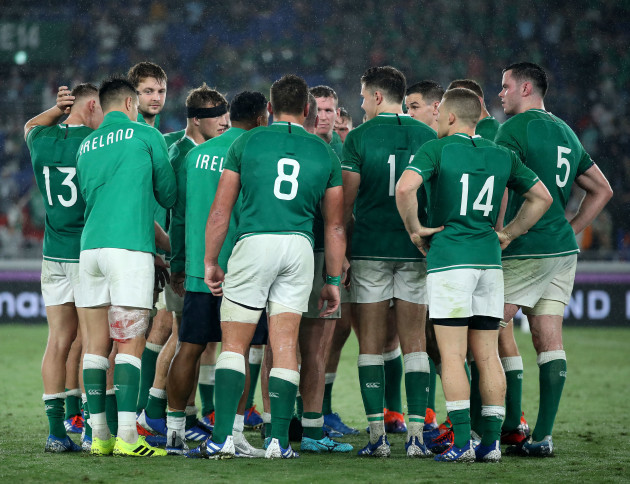A HORRIBLY WET day, a comprehensive defeat of Scotland, and most importantly, an Ireland team who looked back to their rampaging, authoritative best.
After months of doom and gloom surrounding Joe Schmidt’s squad, suddenly all was right with the world again.
Sunday’s 27-3 win in Yokohama was reassuring for a whole host of reasons, but one of the most promising elements of the performance was how Ireland’s forwards completely beat up Scotland in a dominant opening half.
This was significant given that less than nine months ago, Schmidt conceded that Ireland had been ‘bullied’ by England in their opening Six Nations game.
A strong pack has always been central to successful Ireland teams, but the importance of the current forward pack goes far beyond delivering a solid scrum and reliable defence.
For Ireland, the forwards’ contribution in attack is just as important and anything they do behind the ball, evident in the fact that they scored three of Ireland’s four tries against Scotland.
A look back over Ireland’s games over the last two season’s shows just how important the strike-rate of the forwards has been.
Since the start of this year’s Six Nations, Ireland’s forwards have accounted for 12 of the 26 tries scored by Schmidt’s side. That’s a total of 46%.
None of Ireland’s main rivals in Japan lean as heavily on their forward pack when it comes to putting points on the board.
The figures for 2019 are slightly skewed given the nature of the World Cup warm-up games, where results and game plan may not present a true picture of a team’s identity, but even in 2018, the most successful year in the history of Irish rugby, the forwards were a massive source of tries for Ireland, scoring 14 of Ireland’s 43 tries, or 33%.
By comparison, New Zealand’s forwards scored only 17 of their 78 tries that same year, or 22%.
Perhaps more surprising is the fact that that number drops again when you throw a microscope over South Africa’s games.
The Springboks are widely expected to be Ireland’s quarter-final opponents in Japan, and while their extreme physicality up front is often deemed their greatest strength, the forward pack rarely get involved when it comes to scoring tries.
In 2018, the Boks’ forwards scored only 14% of their tries (5 of 37).
The obvious suggestion is that this is simply a result of a different style of rugby being played by the northern and southern hemisphere sides.
We play more wet weather rugby in the northern hemisphere, which has traditionally produced more up-the-jumper rugby and allowed for less flair in the way in our teams play, compared to the running style game so often embraced by the likes of New Zealand and South Africa.
Yet even by northern hemisphere standards, Ireland are producing far more tries from their forwards than their European counterparts.
In 2018, Eddie Jones’ England team scored 34 tries, with only six coming from forwards, a return of 18%. That number has risen to 37% this year, but includes a handful of abnormalities [such as four forwards scoring against an exhausted Ireland in the July warm-up game at Twickenham].
Wales boast a similarly low return from their forward pack.
Last year Wales’ forwards were responsible for just seven of their 37 tries (19%). This year, which has included a Grand Slam-winning Six Nations campaign, the number has slumped to 13%, which the Wales forwards scoring just three of their 23 tries to date.
That means that Ireland’s forwards have scored more tries in 2019 (12) than Wales’ have over the last two years (10). The return from the Ireland pack this year, a season which had been chalked up as a disaster before the win over Scotland, is also one more than that of the South African and New Zealand forwards combined (11).
From these numbers, you can almost draw any conclusion you want.
Are Ireland too reliant on their forwards, and not getting enough tries from their backs?
Possibly. Concentrating on those who have regularly featured in Schmidt’s first choice XV across the last two years, both Tadhg Furlong and Rory Best have scored three tries for Ireland, only one less than Keith Earls. In the same time, Cian Healy (2) has scored more than Rob Kearney (1).
The alternative argument would be that the spread of try-scoring across the forwards and backs is a positive trait that makes Ireland a more difficult proposition for opposition teams.
New Zealand’s backs scored 32 more tries than Ireland in 2018 (they also played two more games), but the year still ended with Steve Hansen claiming Ireland were the favourites for the World Cup after that famous night at Lansdowne Road.
The truth probably lies somewhere between both. If Ireland could bank on more tries from their backs, perhaps the prospect of finally getting past the World Cup quarter-final barrier wouldn’t seem like such a sizable task.
Earlier this week Schmidt described Ireland’s potential quarter-final opponents as ‘heavyweights’ compared to his own ‘light heavyweights’.
The southern hemisphere giants might pack a bigger punch, but Ireland’s forwards certainly bring a greater variety of threats to the ring.
And when they are as hungry for tries as they were against Scotland, Schmidt’s team have more than a fighting chance of beating anyone.
2018/19 totals:
- Ireland: 69 tries scored, 26 by forwards = 38%
- England: 77 tries scored, 22 by forwards = 29%
- New Zealand: 106 tries scored, 23 by forwards = 22%
- South Africa: 57 tries scored, 10 by forwards = 18 %
- Wales: 60 tries scored, 10 by forwards = 17 %.
The42 is on Instagram! Tap the button below on your phone to follow us!


